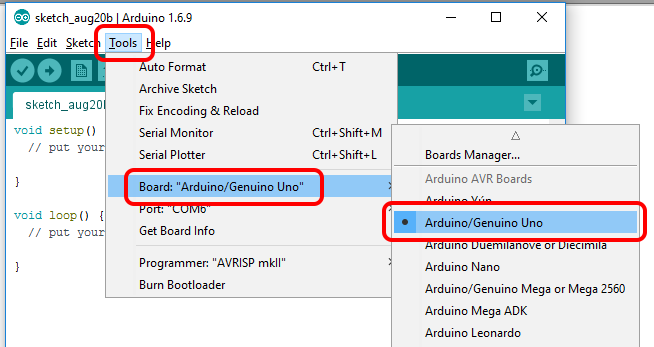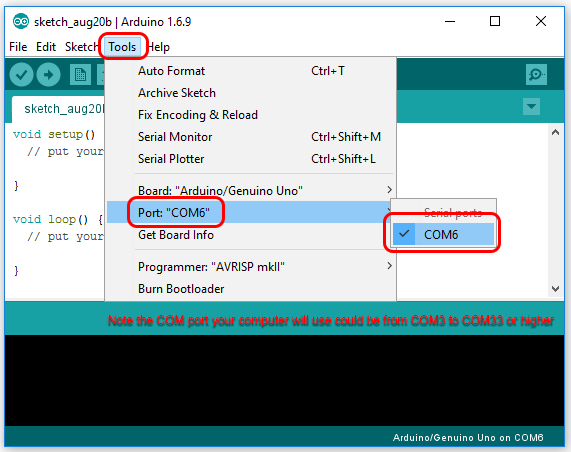/*
Chase LEDs attached on pins 7 - 13
Vary the speed of the chaser based on an Analog Input
Demonstrates analog input by reading the value of a potentiometer (pot) on analog pin A5
The valie of the pot is obtained using analogRead().
The circuit:
Potentiometer attached to analog input A5
center pin of the potentiometer to the analog pin A5
one side pin (either one) to ground
the other side pin to +5V
This example code is in the public domain.
Created by David Cuartielles
modified 30 Aug 2011
By Tom Igoe
modified 8 May 2014
by Scott Fitzgerald
modified 10 August 2016
by rupert.russell@acu.edu.au
*/
int delayMils = 0; // holds the value of the potentiometer
int sensorPin = A5; // select the input pin for the potentiometer
// the setup function runs once when you press reset or power the board
void setup() {
// initialize digital pins 8 - 13 as an outputs.
pinMode(7, OUTPUT);
pinMode(8, OUTPUT);
pinMode(9, OUTPUT);
pinMode(10, OUTPUT);
pinMode(11, OUTPUT);
pinMode(12, OUTPUT);
pinMode(13, OUTPUT);
}
// the loop function runs over and over again forever
void loop() {
delayMils = analogRead(sensorPin); // read the value of the potentiometer
digitalWrite(7, HIGH); // turn the LED on (HIGH is the voltage level)
delayMils = analogRead(sensorPin); // we want to read the value again because it may have changed
delay(delayMils);
digitalWrite(8, HIGH); // turn the LED on (HIGH is the voltage level)
delayMils = analogRead(sensorPin); // if we only read the value of the pot once per cycle the program is slower to respond to changes
delay(delayMils);
digitalWrite(9, HIGH); // turn the LED on (HIGH is the voltage level)
delayMils = analogRead(sensorPin);
delay(delayMils);
digitalWrite(10, HIGH); // turn the LED on (HIGH is the voltage level)
delayMils = analogRead(sensorPin);
delay(delayMils);
digitalWrite(11, HIGH); // turn the LED on (HIGH is the voltage level)
delayMils = analogRead(sensorPin);
delay(delayMils);
digitalWrite(12, HIGH); // turn the LED on (HIGH is the voltage level)
delayMils = analogRead(sensorPin);
delay(delayMils);
digitalWrite(13, HIGH); // turn the LED on (HIGH is the voltage level)
delayMils = analogRead(sensorPin);
delay(delayMils);
// Now turn off in sequence
digitalWrite(7, LOW); // turn the LED off by making the voltage LOW
delayMils = analogRead(sensorPin);
delay(delayMils);
digitalWrite(8, LOW); // turn the LED off by making the voltage LOW
delayMils = analogRead(sensorPin);
delay(delayMils);
digitalWrite(9, LOW); // turn the LED off by making the voltage LOW
delayMils = analogRead(sensorPin);
delay(delayMils);
digitalWrite(10, LOW); // turn the LED off by making the voltage LOW
delayMils = analogRead(sensorPin);
delay(delayMils);
digitalWrite(11, LOW); // turn the LED off by making the voltage LOW
delayMils = analogRead(sensorPin);
delay(delayMils);
digitalWrite(12, LOW); // turn the LED off by making the voltage LOW
delayMils = analogRead(sensorPin);
delay(delayMils);
digitalWrite(13, LOW); // turn the LED off by making the voltage LOW
delayMils = analogRead(sensorPin);
delay(delayMils);
}
|


